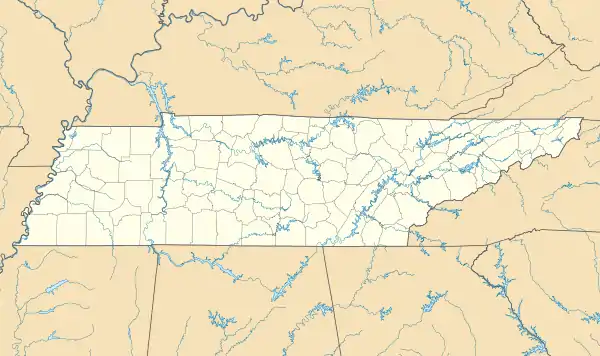Airdrie | |
  | |
| Location | 3210 Avenal Avenue, Nashville, Tennessee, U.S. |
|---|---|
| Coordinates | 36°06′11″N 86°43′54″W / 36.1031°N 86.7318°W |
| Area | 2.8 acres (1.1 ha) |
| Built | c.1797-c. 1805; c. 1910 |
| Architect | George Norton |
| Architectural style | Neoclassical |
| NRHP reference No. | 05001027[1] |
| Added to NRHP | September 15, 2005 |
Airdrie, a.k.a. Petway House or the Buell-King House, is a historic house and former plantation in Nashville, Tennessee. Built as a log house from 1797 to 1808, it was a Southern plantation with African slaves in the Antebellum era. After the American Civil War, it belonged to Union veterans.
Location
It is located at 3210 Avenal Avenue in South-East Nashville, the county seat of Davidson County, Tennessee.[2][3][4]
History
The land belonged to John Foreman until it was acquired by William Coldwell in 1797.[4] The construction of the two-story log house began in 1797, and it was completed c. 1808.[3][4] It included an adjacent log cabin and a horse barn.[4]
In 1808, Coldwell sold the house to Congressman William Dickson, who served in the United States House of Representatives from 1801 to 1807.[4] In 1817, it was purchased by Congressman Thomas Claiborne, who served in the House of Representatives from 1817 to 1819.[3] However, Claiborne sold the house in 1818 to Justice Gilbert Gray Washington, who served in the Tennessee Supreme Court.[3]
In 1825, the house was purchased by Hinchey Petway (1776-1856), a merchant active in Franklin, Tennessee who remained the owner throughout the 1830s and 1840s.[3] Today, the Hincheyville Historic District in Franklin is named for Petway.[3] Petway added more land, coming up to 431 acres, and he owned African slaves, who worked on what was by then a Southern plantation.[3] He lived there with his wife, Susanna Caroline Parrish Petway, and their seven children.[3] When Petway died in 1856, the house was willed to his widow and their children.[3] It remained in the Petway family during the Civil War.[3]
In 1866–1867, the house was purchased by Judge John S. Brien.[4][5] When he died in 1867, the house was inherited by his widow, Rochie Howard Brien (1840-1930), who lived there until her death.[3] She shared the house with her daughter Rochie, her son-in-law, Union Colonel George P. Buell, who was General Buell's cousin and became the owner of the house, and her grandson, Don Carlos Buell II.[4] Buell hired architect George Norton to redesign the house in the Neoclassical architectural style circa 1910.[3][4] Norton added poplar weatherboard, a front porch, and a grand staircase inside the house.[3] Meanwhile, Don Carlos Buell II married Ruth Norton, the architect's sister, and they lived in the house until the 1950s.
In 1953, Ward Allen, a Professor of English at Vanderbilt University, purchased the house from Ruth Norton Buell.[3] He welcomed meetings of St Matthias Episcopal Church and lived here with his wife Peggy until 1958,[3] when they sold the house to Charles Toney and his wife Josephine.[3] In 1963, the house was purchased by R. Harold King and his wife, Dorothy.[3] The Kings renovated the house.[3]
Architectural significance
It has been listed on the National Register of Historic Places since September 15, 2005.[2]
References
- ↑ "National Register Information System". National Register of Historic Places. National Park Service. July 9, 2010.
- 1 2 "Airdrie". National Park Service. Retrieved September 24, 2015.
- 1 2 3 4 5 6 7 8 9 10 11 12 13 14 15 16 17 18 "National Register of Historic Places Registration Form: Airdrie". National Park Service. Retrieved September 24, 2015. Associated photos
- 1 2 3 4 5 6 7 8 Zepp, George (May 8, 2007). "Woodbine area sprouted from rocky past". The Tennessean. Nashville, Tennessee. Retrieved September 24, 2015.
- ↑ Owsley, Harriet C., ed. (March 8, 1960). "BUELL-BRIEN PAPERS 1805-1943" (PDF). Tennessee State Government. Archived from the original (PDF) on July 17, 2015. Retrieved September 24, 2015.